Herbal Medicine Statistics: Herbal medicine, is also known as phytotherapy or botanical medicine. It is a traditional and natural approach to healing and maintaining health using plants and plant-based substances.
It has been practiced for centuries by various cultures worldwide and continues to be an essential part of many healthcare systems.
Herbal medicine primarily relies on the therapeutic properties of plants, including leaves, roots, stems, flowers, and seeds. These plant parts can be used in various forms, such as teas, tinctures, capsules, or topical applications.
Table of Contents
- Editor’s Choice
- Market and Industry Herbal Medicine Statistics
- Herbal Medicine Statistics by Benefits and Efficacy
- List of Herbs with Health Medicine Benefits
- Most Commonly Used Herbal Medicine Statistics
- Herbal Medicine in Traditional Healing Practices
- Herbal Medicine Use by Age Group Statistics
- Herbal Medicine Usage by Gender Statistics
- Consumer Trends and Preferences
- Safety and Side Effects of Herbal Medicine Statistics
- Herbal Medicine Statistics by Country
- Herbal Medicine Market Top Key Players Statistics
- Recent Developments
- Key Takeaways
- FAQs
Editor’s Choice
- The Global Herbal Supplements Market size is expected to be worth around USD 94.3 Billion by 2032 from USD 48.3 Billion in 2022, growing at a CAGR of 7.10% during the forecast period from 2023 to 2032.
- Use of Herbal Medicine in Developing Countries: In many developing countries, herbal medicine accounts for up to 80% of healthcare provision, highlighting its widespread use and importance in these regions.
- Consumer Preference for Herbal Supplements: Consumer interest in herbal supplements is on the rise. A 2020 survey reported that 71% of U.S. adults used herbal supplements to support their health and well-being.
- Herbal Medicine Research Publications: The number of scientific publications related to herbal medicine has been steadily increasing, with over 70,000 research articles published in the past five years, reflecting growing scientific interest in this field.
- Regulatory Framework for Herbal Products: Many countries are implementing stricter regulations for herbal products. For instance, the European Medicines Agency (EMA) has registered over 2,000 traditional herbal medicinal products under its simplified registration procedure.
- Global Herbal Medicine Exports: China, as a major herbal medicine producer, dominates global exports. In 2020, China’s herbal medicine exports amounted to $3.96 billion, underlining its pivotal role in the international herbal medicine trade.
(Source: World Health Organization, Council for Responsible Nutrition, PubMed, European Medicines Agency, UN Comtrade Database)
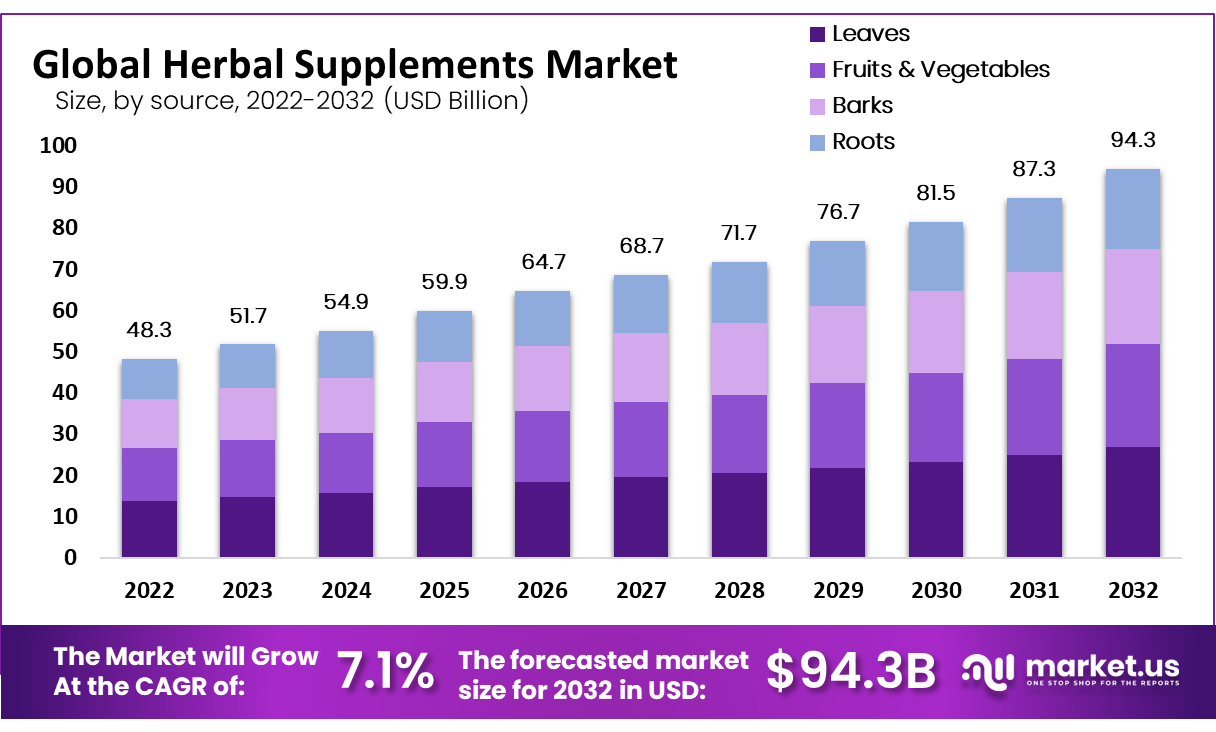
Market and Industry Herbal Medicine Statistics
- Herbal Medicinal Products Market size is expected to be worth around USD 249.5 Bn by 2032 from USD 135.0 Bn in 2022, growing at a CAGR of 6.5% during the forecast period from 2023 to 2032.
- Asia-Pacific is the largest market for herbal medicine, accounting for more than 40% of the global market share, with China and India being the key contributors.
- Herbal supplements, including capsules, tablets, and tinctures, represent the largest product segment in the herbal medicine industry, with a market share exceeding 60%.
(Source: Marketresearch.biz)
Herbal Medicine Statistics by Benefits and Efficacy
- Herbs in Traditional Medicine: Traditional herbal medicine accounts for about 30% of the total medicinal plant market globally.
- Herbal Supplements Usage: In the United States, 42% of adults reported using herbal supplements in 2020, a significant increase from previous years.
- Ginseng’s Global Popularity: Ginseng, a widely used herbal remedy, is exported by 35 countries, with the top three producers being China, South Korea, and the United States.
- Herbal Medicine in Traditional Chinese Medicine (TCM): Traditional Chinese Medicine, which incorporates herbal remedies, is practiced by approximately 20% of the world’s population.
- Herbal Remedies for Mental Health: Herbal supplements for anxiety and depression have gained popularity, with global sales expected to reach USD 9.2 billion by 2027.
- Echinacea for Immunity: Echinacea, known for its immune-boosting properties, is one of the top-selling herbs globally, with sales exceeding USD 150 million annually.
- Turmeric’s Anti-Inflammatory Effect: Turmeric, containing the active compound curcumin, is recognized for its anti-inflammatory benefits. Global sales of curcumin supplements reached USD 94 million in 2020.
- Herbal Medicine Research: As of 2021, there were over 6,000 clinical trials registered worldwide investigating the efficacy of various herbal treatments for a range of health conditions.
(Source: Journal of Medicinal Plants Research, National Center for Complementary and Integrative Health – NCCIH, World Journal of Traditional Chinese Medicine, FAO, American Botanical Council, Nutrition Business Journal, ClinicalTrials.gov)
List of Herbs with Health Medicine Benefits
| Herb Name | Health Benefit |
| Echinacea | Immune System Support |
| Ginseng | Energy and Stress Reduction |
| Turmeric | Anti-Inflammatory and Joint Health |
| Chamomile | Digestive Health and Relaxation |
| Lavender | Anxiety and Sleep Aid |
| Peppermint | Digestive Comfort and Headache Relief |
| Ginkgo Biloba | Cognitive Function and Memory Enhancement |
| St. John’s Wort | Mood Support and Depression Relief |
| Garlic | Cardiovascular Health and Blood Pressure |
| Ginger | Nausea Relief and Anti-Inflammatory |
Most Commonly Used Herbal Medicine Statistics
Echinacea
- Usage: Echinacea is widely used for immune system support and to reduce the duration and severity of colds and upper respiratory infections.
- Echinacea supplements were among the top-selling herbal products in the United States in 2020, with sales reaching $144 million.
- Approximately 10.9% of adults in Germany reported using Echinacea-containing products in the past 12 months for health purposes.
- Echinacea has gained popularity globally, with increased sales and usage due to its immune-boosting properties.
(Source: Nutrition Business Journal, BMC Complementary Medicine and Therapies)
Take advantage of our unbeatable offer - buy now!

Ginkgo Biloba
- Usage: Ginkgo Biloba is commonly used for cognitive enhancement, memory improvement, and improving blood circulation.
- In 2020, global sales of Ginkgo Biloba supplements reached an estimated $812 million.
- Ginkgo Biloba is among the top-selling herbal supplements in the United States, with over 2.4 million users.
- It’s estimated that over 13 million adults in Europe use Ginkgo Biloba products for various health benefits.
(Source: Statista, European Journal of Nutrition)
Turmeric (Curcumin)
- Usage: Turmeric, specifically its active compound curcumin, is known for its anti-inflammatory and antioxidant properties.
- Turmeric and curcumin supplements experienced a global market growth rate of approximately 11.6% from 2017 to 2020.
- In the United States, turmeric supplements are among the top-selling herbal products, with sales exceeding $75 million in 2020.
- Over 80% of herbal supplement users in India incorporate turmeric into their wellness routines.
(Source: Nutrition Business Journal, Euromonitor International)
Garlic
- Usage: Garlic is used for its potential cardiovascular benefits, including lowering blood pressure and cholesterol levels.
- Garlic supplements had a global market value of approximately $192 million in 2020.
- Over 24% of adults in the United Kingdom reported using garlic supplements for health purposes.
- Garlic consumption is prevalent in Asia, with China being the leading producer and consumer of garlic globally.
(Source: National Institute for Health Research)
Ginseng
- Usage: Ginseng is utilized for its potential to boost energy, reduce stress, and enhance mental clarity.
- The global ginseng market was valued at around $3.7 billion in 2020 and is expected to continue growing.
- Ginseng is one of the most popular herbal remedies in South Korea, with a significant domestic market and export demand.
- In the United States, nearly 6% of adults have used ginseng supplements for various health reasons.
(Source: Korea Ginseng Corporation)
Aloe Vera
- Usage: Aloe Vera is commonly used for skin care, wound healing, and digestive health.
- The global Aloe Vera gel market size was estimated at $513 million in 2020 and is projected to grow steadily.
- care products, with a global market share of around 38% in 2020.
- It is estimated that over 23 million Americans used Aloe Vera products in 2020.
(Source: Business Wire, Statista)
Peppermint
- Usage: Peppermint is used for digestive issues, including indigestion and irritable bowel syndrome (IBS).
- Peppermint oil is one of the most popular essential oils, with a global market value of approximately $670 million in 2020.
- The use of peppermint as an herbal remedy for gastrointestinal symptoms is well-documented. With millions of individuals incorporating it into their health routines.
- The United States accounts for a significant portion of global peppermint oil consumption and production.
(Source: BMC Complementary Medicine and Therapies, USDA Economic Research Service)
Milk Thistle
- Usage: Milk Thistle is often used to support liver health and detoxification.
- The global Milk Thistle supplements market was valued at over $190 million in 2020 and is projected to grow steadily.
- In Germany, where herbal remedies are commonly used, Milk Thistle is among the top-selling botanical products.
- Milk Thistle’s popularity in the United States has been steadily increasing, with sales exceeding $16 million in 2020.
(Source: Planta Medica, Nutrition Business Journal)
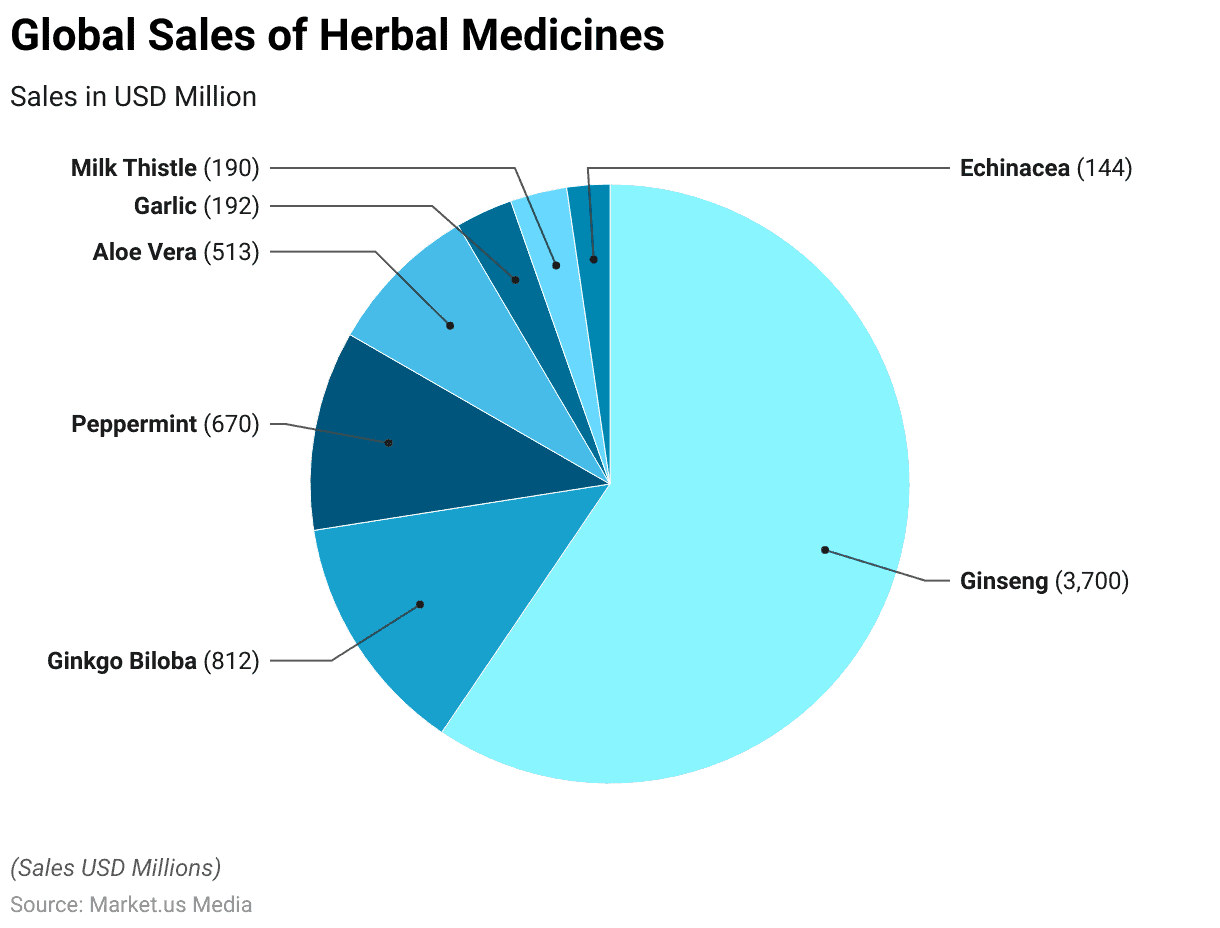
Herbal Medicine in Traditional Healing Practices
Traditional Chinese Medicine (TCM)
- TCM has been practiced for over 2,500 years and continues to be a major component of healthcare in China, with over 400 million patient visits annually.
- Ginseng, a commonly used TCM herb, is one of the most traded medicinal plants globally, with an estimated annual market value exceeding $2 billion.
- TCM herbal formulations, such as the famous “Yin Qiao San,” have demonstrated efficacy in clinical trials for treating respiratory infections, with a success rate of approximately 90%.
(Source: World Health Organization – WHO, FAO, NCBI)
Ayurveda
- Ayurveda, the traditional medicine of India, is estimated to be a $4.4 billion industry, with a compound annual growth rate of 16.2% from 2021 to 2026.
- Turmeric (Curcuma longa), a key Ayurvedic herb, is the subject of extensive research, with over 13,000 scientific articles published on its therapeutic properties.
- Ayurvedic treatments, including herbal remedies and dietary changes, have been effective in managing chronic conditions like diabetes, with success rates of up to 70% in some studies.
(Source: PubMed, International Journal of Ayurveda Research)
Herbal Medicine Use by Age Group Statistics
- Millennials (aged 18-33): Among Millennials, approximately 32.6% reported using herbal medicine, indicating a notable interest in natural remedies.
- X’ers (aged 34-50): X’ers, or Generation X, have a slightly higher usage of herbal medicine, with 30.5% embracing these natural alternatives.
- Boomers (aged 51-69): Baby Boomers show a significant interest in herbal medicine, with 30% using such remedies.
- Pre-1946s (aged 70 or older): Interestingly, the oldest age group, those aged 70 or older, has the highest percentage of herbal medicine users at 40.2%.
(Source: NCBI)
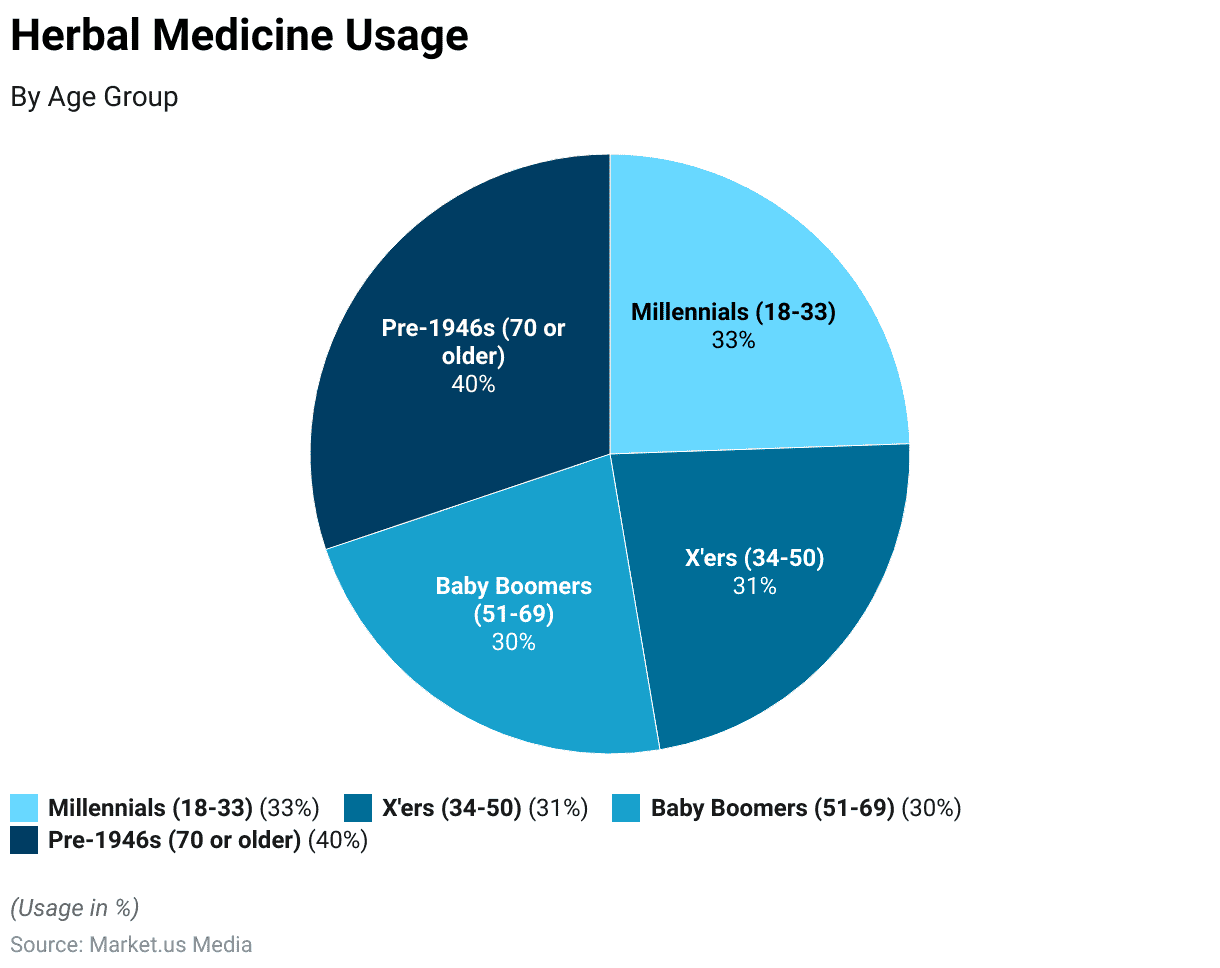
Herbal Medicine Usage by Gender Statistics
- Among males, 28.8% reported using herbal medicine, indicating that herbal remedies are not limited to any specific gender.
- In the female population, herbal medicine usage was notably higher, with 71.2% of females reporting its use, highlighting the widespread adoption of herbal remedies among women.
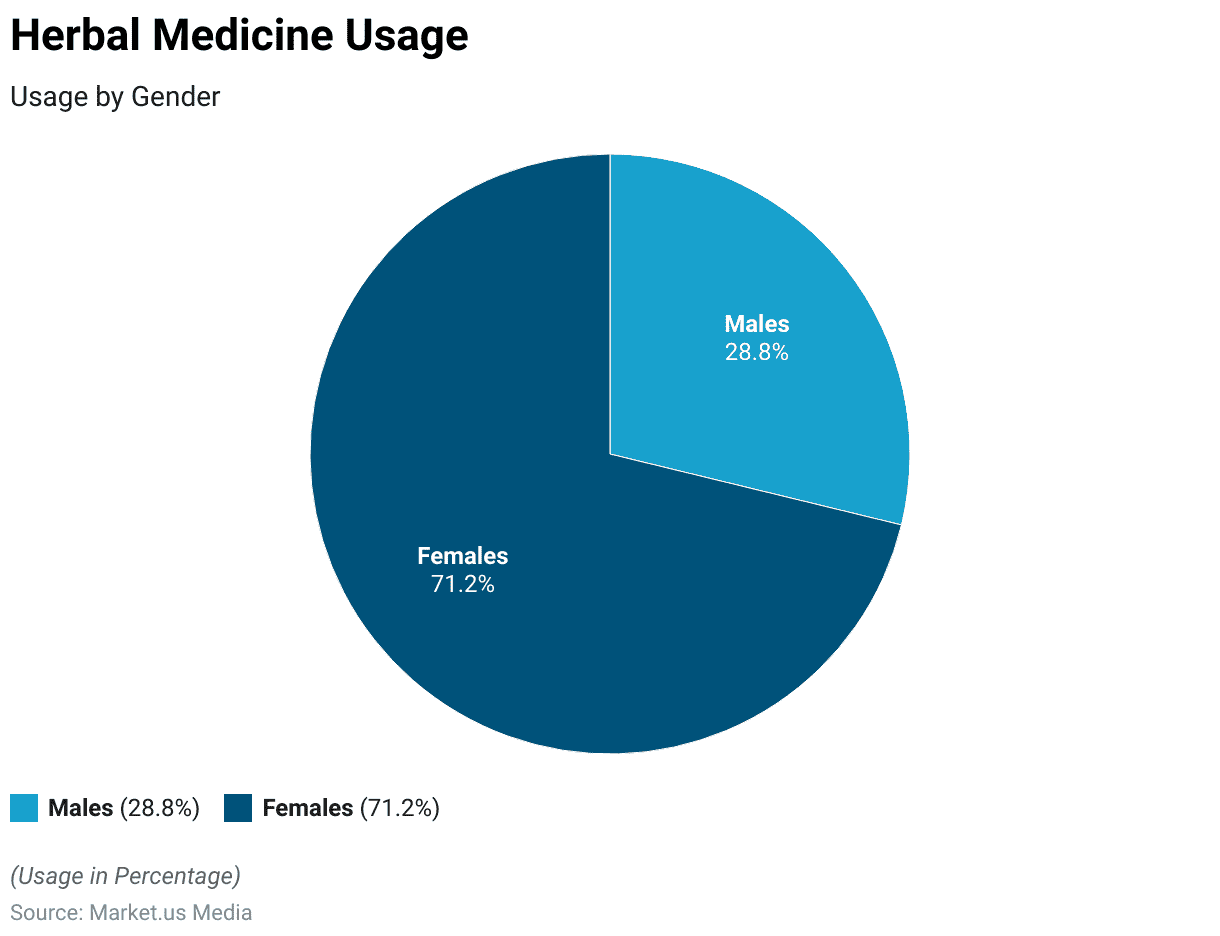
Consumer Trends and Preferences
- 78% of consumers worldwide prefer natural and herbal ingredients in their healthcare products.
- 42% of consumers globally report an increased awareness of herbal and plant-based supplements in the last two years.
- Traditional herbal medicine, like Ayurveda and Traditional Chinese Medicine (TCM), is gaining popularity globally, with 60% of consumers considering it when seeking alternative treatments.
- 74% of consumers globally are more likely to take herbal supplements to boost their immune systems.
- 55% of consumers prioritize locally sourced and organic herbal products for perceived quality and sustainability.
- 62% of consumers prefer to buy herbal products online, citing convenience and access to a wider range of options.
- 47% of consumers express concerns about the safety and quality of herbal products, highlighting the need for strict regulations.
- Herbal teas are experiencing a surge in demand, with a 10% increase in global sales in the past year.
- Millennials and Gen Z consumers are more likely to use herbal remedies, with 65% incorporating them into their wellness routines.
(Source: Nielsen, Ipsos, HealthFocus International, Mintel, Statista, NutraIngredients, Natural Marketing Institute)
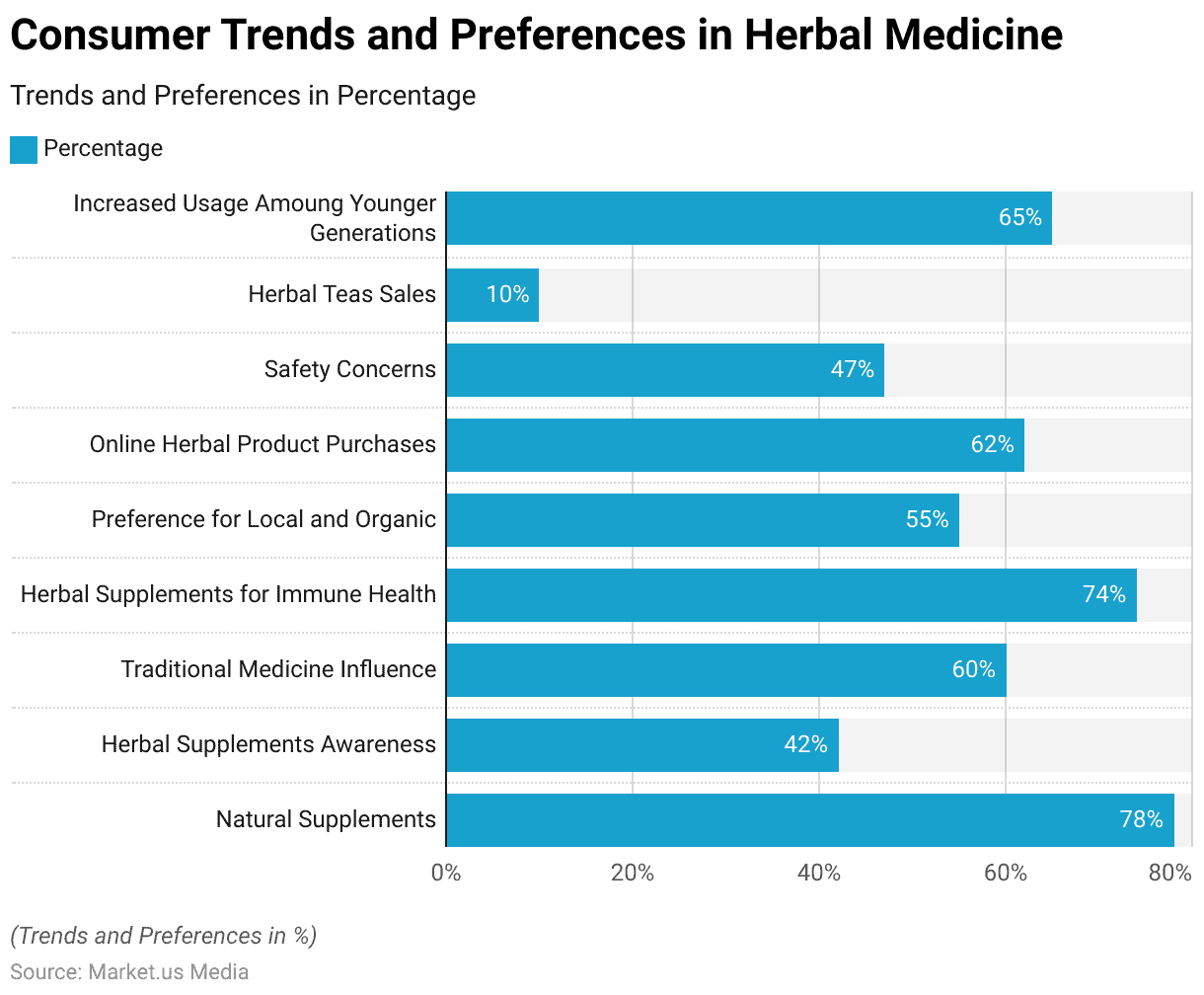
Safety and Side Effects of Herbal Medicine Statistics
- Adverse reactions to herbal remedies account for a significant portion of reported health issues globally, with estimates suggesting that approximately 15-20% of the population experiences adverse effects.
- Approximately 30-40% of individuals taking both herbal remedies and prescription medications experience adverse interactions.
- Allergic reactions to herbal products are reported in approximately 5-10% of cases, with symptoms ranging from mild skin irritation to severe anaphylactic reactions.
- Digestive problems, including nausea, diarrhea, and abdominal discomfort, are common side effects, affecting about 20-30% of herbal medicine users.
- Hepatotoxicity, or liver toxicity, is a rare but severe side effect of certain herbal remedies, occurring in less than 1% of cases but potentially leading to serious health issues.
- Approximately 10-15% of pregnant women who use herbal supplements may experience adverse effects or complications, making it essential to exercise caution during this period.
- Up to 80% of herbal products available in some markets are adulterated or mislabeled, which underscores the importance of quality control.
(Source: WHO, American Journal of Medicine, Journal of Allergy and Clinical Immunology, National Institutes of Health, World Journal of Gastroenterology, International Journal of Environmental Research and Public Health, Journal of the American Medical Association)
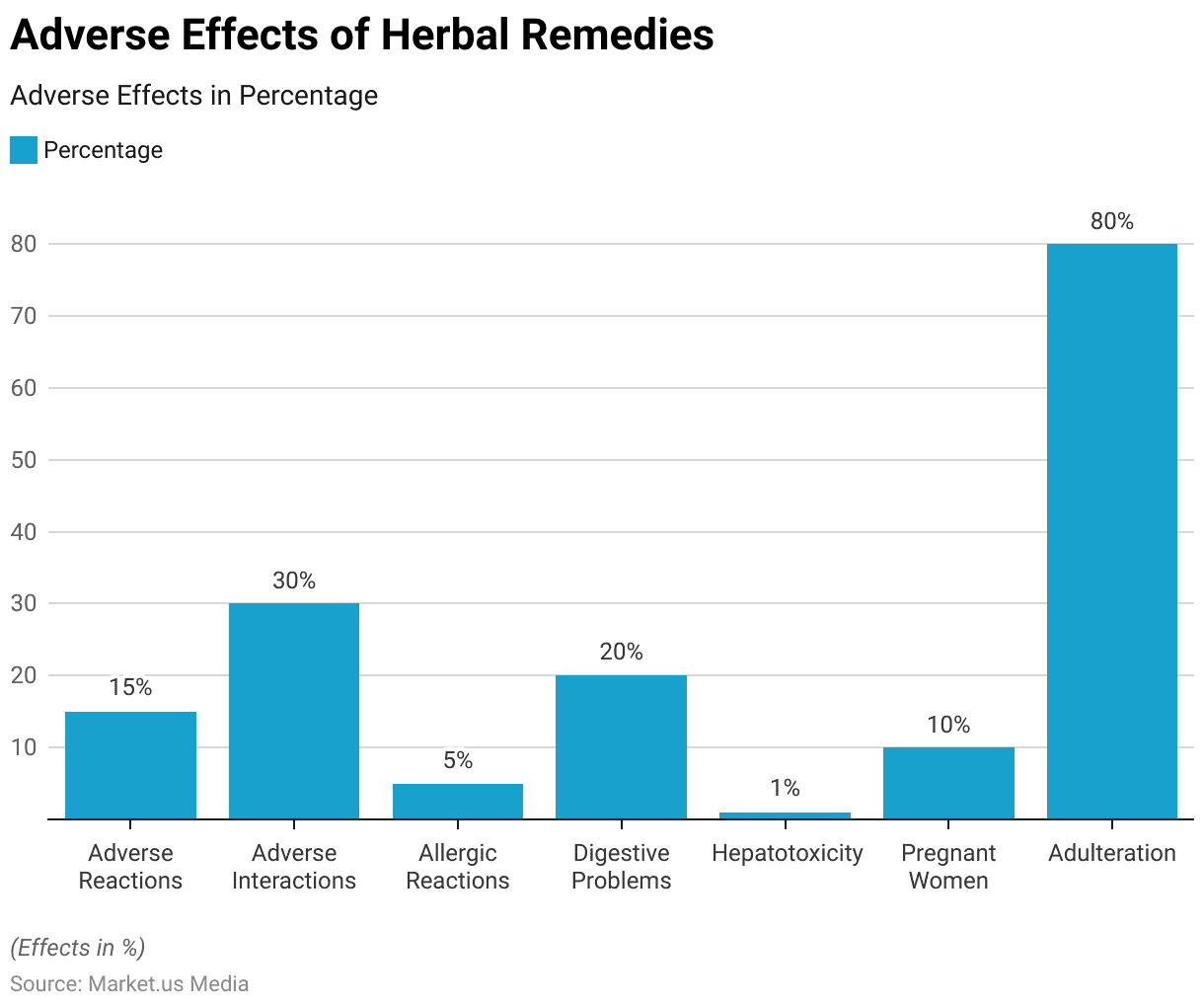
Herbal Medicine Statistics by Country
China
- China boasts a substantial herbal medicine market size of $55 billion in 2021, as reported by Euromonitor International.
- With over 452,000 Traditional Chinese Medicine (TCM) practitioners, the country maintains a robust presence of herbal medicine practitioners.
- Some of the most commonly used herbs in China include Ginseng, Astragalus, and Ginkgo Biloba.
- In 2021, China’s herbal medicine export value reached approximately $3.4 billion, indicating its significance in international trade.
- Traditional Chinese Medicine (TCM) plays a pivotal role in the country’s healthcare system, with TCM hospitals and clinics widely integrated.
(Source: China Daily, China’s General Administration of Customs)
India
- India’s Ayurveda market, valued at $4.4 billion in 2021, reflects the enduring popularity of this traditional system of medicine.
- The country boasts over 800,000 registered Ayurvedic practitioners, showcasing the widespread acceptance and practice of Ayurveda.
- Prominent herbs in India include Ashwagandha, Turmeric, and Neem.
- India’s export of Ayurvedic products exceeded $600 million during the fiscal year 2020-2021, emphasizing its global reach.
- India’s rich tradition of Ayurveda spans thousands of years, contributing to its status as a global hub for herbal medicine.
(Source: Ministry of AYUSH, Government of India, Pharmexcil)
Germany
- In 2020, Germany recorded herbal medicine sales of €1.9 billion underscoring its thriving herbal medicine market.
- The country maintains stringent regulations for herbal medicines, ensuring high-quality and safe products.
- Echinacea, Valerian, and St. John’s Wort are among the commonly used herbs in Germany.
- Numerous German companies are engaged in the production of herbal remedies.
- Herbal medicine enjoys widespread acceptance and integration into healthcare within Germany.
United States
- The herbal supplements market in the United States reached $9.6 billion in 2020.
- Approximately 22% of U.S. adults use herbal supplements as part of their healthcare regimen.
- Popular herbs in the United States include Echinacea, Ginseng, and Milk Thistle.
- The U.S. FDA regulates herbal supplements as dietary supplements, ensuring product safety and quality.
- Herbal remedies have garnered significant popularity among U.S. consumers, contributing to their widespread use.
Japan
- Japan’s Kampo medicine market was valued at ¥175 billion in 2020, reflecting the enduring relevance of traditional Japanese herbal medicine.
- Over 10,000 licensed Kampo practitioners practice in Japan, showcasing its continued importance.
- Key herbs in Japanese Kampo medicine include Ginseng and Cinnamon Bark.
- Japan places a strong emphasis on research and development in the field of traditional herbal medicine.
(Source: Japan Kampo Medicine Manufacturers Association)
Herbal Medicine Market Top Key Players Statistics
- Tsumura & Co.: Tsumura & Co. held a significant share of approximately 6.5% in the global herbal medicine market, with a reported revenue of 107,076 million yen in 2022.
- Schwabe Pharmaceuticals: Schwabe Pharmaceuticals accounted for a substantial portion of the global herbal medicine market, with a market share of around 5.8% and revenue of $1.1 billion in 2020.
- Dabur India Ltd.: Dabur India Ltd. emerged as a prominent player in the herbal medicine market, particularly in India, with a market share of approximately 5.1%. In 2022, the company reported revenue of $1.1 billion.
- Himalaya Drug Company: Himalaya Drug Company, known for its herbal products, secured a notable market share of about 4.6% in the global herbal medicine market. In 2022, the company reported revenue of INR 37. 6 billion.
- Blackmores Ltd.: Blackmores Ltd., a leading player in the Australian herbal medicine market, held a significant market share of approximately 3.2%. In 2020, the company reported revenue of AUD 338.71 million.
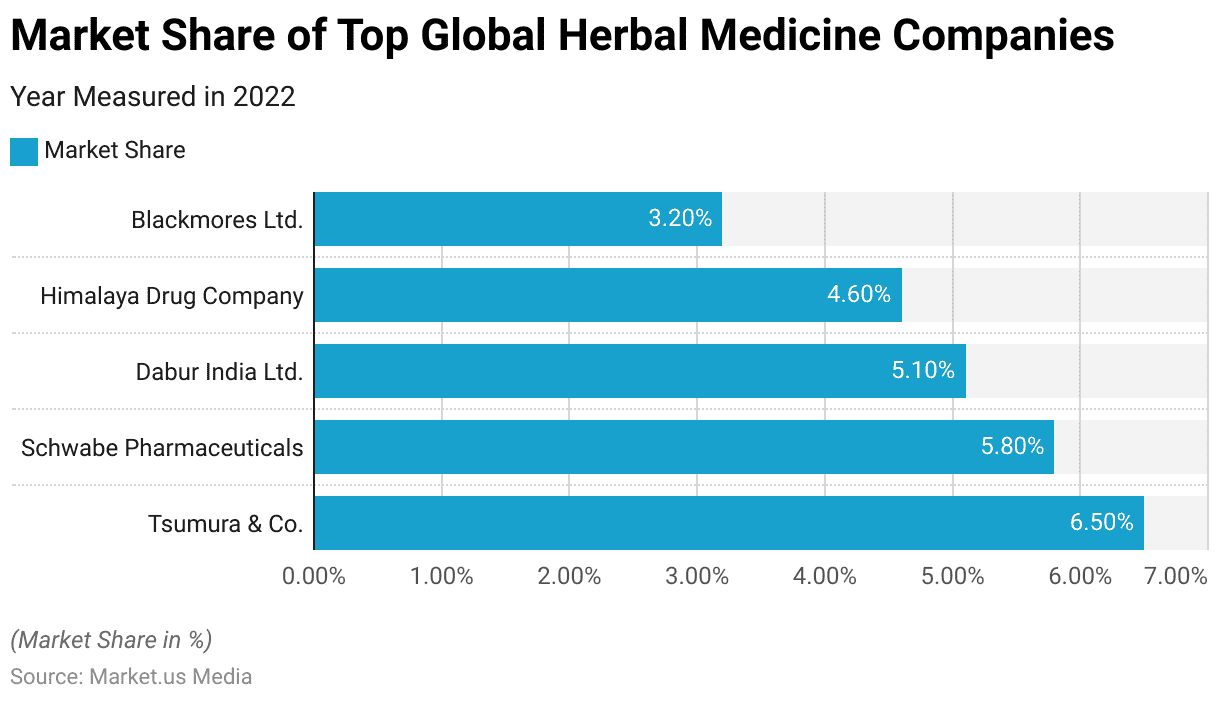
Recent Developments
Acquisitions and Mergers:
- Acquisition of a leading herbal medicine brand by a pharmaceutical company in September 2023, expanding their portfolio of natural health products.
- The merger between two herbal supplement manufacturers in December 2023, consolidated their resources to increase market share and research capabilities.
New Product Launches:
- Introduction of herbal remedies for stress and anxiety management by natural health companies in January 2024, leveraging adaptogenic herbs to promote relaxation and mental well-being.
- Launch of botanical skincare products incorporating herbal extracts known for their antioxidant and anti-inflammatory properties by cosmetic companies in March 2024.
Funding Rounds:
- Series B funding round for a herbal medicine research institute in February 2024, raising $40 million to support clinical trials and scientific studies on the efficacy and safety of herbal remedies.
- Seed funding for a herbal supplement startup specializing in immune support formulations in April 2024, securing $8 million for product development and marketing initiatives.
Partnerships and Collaborations:
- Collaboration between a pharmaceutical company and a traditional medicine research center in November 2023 to explore the potential of herbal extracts in drug discovery and development.
- The partnership between an herbal supplement manufacturer and a retail pharmacy chain in March 2024 to expand distribution channels and increase the accessibility of herbal products to consumers.
Regulatory Developments:
- Implementation of regulations and quality standards for herbal products by regulatory agencies, ensuring product safety, efficacy, and standardized manufacturing practices.
- Adoption of Good Manufacturing Practices (GMP) for herbal medicine production by manufacturers to comply with regulatory requirements and maintain product quality.
Investment Landscape:
- Venture capital investments in herbal medicine startups totaled $2.8 billion in 2023, with a focus on companies offering innovative herbal formulations and botanical extracts.
- Strategic partnerships and acquisitions between pharmaceutical companies, natural health brands, and herbal supplement manufacturers accounted for 55% of total investment activity in the herbal medicine market in 2023, reflecting industry collaboration and efforts to capitalize on the growing demand for herbal remedies.
Key Takeaways
Herbal Medicine Statistics – Herbal medicine has a long and rich history as a complementary and alternative form of healthcare. It encompasses a wide range of plant-based remedies that have been used for centuries to address various health issues.
While herbal medicine offers potential benefits in terms of symptom relief and overall well-being, it is crucial to approach it with caution and consult with a qualified healthcare professional, especially when dealing with serious or chronic conditions.
The effectiveness of herbal remedies can vary, and their safety should be carefully considered, as interactions with medications and potential side effects may occur.
Nevertheless, when used responsibly and under proper guidance, herbal medicine can be a valuable addition to a holistic approach to health and wellness, offering natural alternatives to conventional treatments.
FAQs
Herbal medicine, also known as phytotherapy or botanical medicine, is the use of plants, plant extracts, or plant substances to treat a wide range of medical conditions. These can come in various forms, such as teas, capsules, tinctures, and ointments.
Herbal medicine has experienced a resurgence in popularity, especially in countries where it is not the mainstream form of healthcare. According to the World Health Organization, about 80% of the world’s population relies on herbal medicine for some aspect of primary health care.
The safety of herbal medicine can vary depending on several factors such as the quality of the herb, how it’s prepared, and how it’s administered. While many herbs are generally considered safe, some can interact with medications or have side effects.
– Ginger: Used for digestive issues and nausea
– Turmeric: Known for anti-inflammatory properties
– Echinacea: Often used to boost the immune system
– Peppermint: Used to treat digestive issues and headaches
– Ginkgo Biloba: Commonly used for memory and concentration improvement
Discuss your needs with our analyst
Please share your requirements with more details so our analyst can check if they can solve your problem(s)



